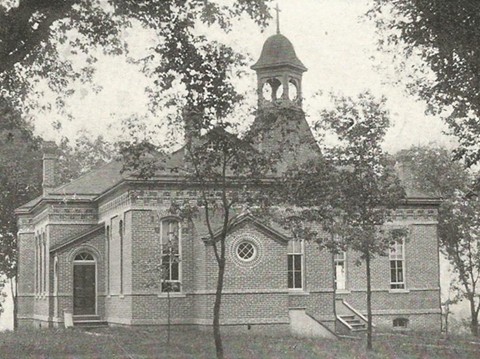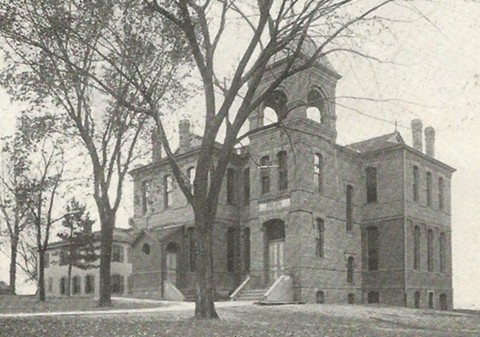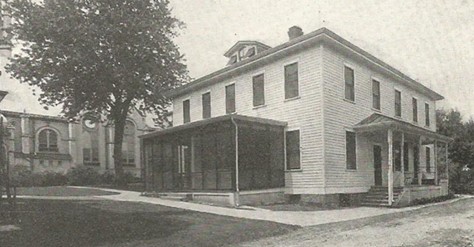p.34
The mind of the Catholic Church is a most beautiful creation. As an organic institution, the Church would share that mind with her children, her religious orders, and diverse institutions. To a greater or lesser degree everything truly Catholic has something of her color, of her makeup. Nor is it easy for her to impart that mind, that attitude. Yet she would impart it, and impart it to each of her children individually. The Sunday morning Mass and sermon and other occasional services she deems not sufficient ordinarily to accomplish it. So, when impressions mean most, when they can be well night indelibly impressed, she takes her little ones by the hand and heart and tells them in accents both beautiful and grave the meaning and need of Catholic thinking and living. Her method is no uncertain, haphazard one; no, but the daily pouring in and drawing out of Catholic ways of believing and thinking and Catholic ideals of living.
Nor does the Catholic Church wait for the full blown development of her institutional life before starting the daily striving with her precious little ones. Bishop Loras used often to say: “First the school and then the Church.” Those words of his have been a never failing inspiration to his priests, and, in a particular way to dear Father Laurent. Let us gaze intently on Catholic educational effort here in St. Matthias’. The Walton Pioneer Papers are authority for the statement that Father Laurent began his parochial school in 1852. We do know, though, that in 1853 there were many Catholic children attending the public school. In a letter dated April 8, 1879, Mr. G. B. Denison, the first principal of the first graded public school in Muscatine writes, referring to the year 1853: “ There were at that time many children of Catholic parents attending the school, as they had a right to do, and of course which he (the President of the board) proposed to pursue they looked upon as an infringement of their conscientious religious scruples. In short, they would be compelled to yield their religious convictions or leave school. I claimed …
p. 35
… that the public schools, being supported by public funds, should be entirely free from sectarian influences; that they should be so conducted, that people of all shades of religious opinion could meet on one common platform, where the children of all sects and creeds could study the same text books and recite in the same classes under the same …
 St. Matthias School 1888 |
… teachers. That would make them as I believe, what the law contemplated, ‘public schools, free to all.’” It is interesting to note that Mr. Denison’s attitude was sustained by the voters of the district in the following election.
Now to return to the first St. Matthias School. In 1894 the scholarly Father Laurent wrote a lengthy article on “ Early Catholic Schools in Iowa.” His remarks about Muscatine are pertinent and interesting enough to be quoted” “ In Davenport, Muscatine, and Lyons and wherever…
p.36
… a school building could not be procured, the church was used on weekdays as a school house; a curtain extending across the church divided the sanctuary from the bottom of the church where the school was kept.” In another place he tells us: “ Antoine Le Claire, one of the founders of Davenport, used to say that Muscatine was suburb of Davenport, but when it came to help the so-called suburb Antoine could not be persuaded either by English or French arguments to do anything in behalf of the struggling first Catholic settlers of the City on the bend. He was excessively generous, even to a fault, for Davenport, but he thought Muscatine should take care of herself … School was taught spasmodically in the church till 1853 when a brick ‘L’ addition was appended to the Church with sliding doors. The difficulty was to find and maintain a teacher; the congregation was small and there was no money but store pay and corporation orders worth what you could get for them. Better days came with the first Iowa railroad in 1855,viz., from Davenport via Wilton plug. The church property, one lot, was sold in 1856 and the present location secured and the church built and occupied in 1856. School was taught in the gallery (of the new church) by Capt. Felix Doran till ’58 when a frame building 20 by 30 was erected. In 1862 the Sisters of Charity, B.V. M., came. Improvements, school accommodations were made as needed and on 1866 the number of pupils was at least 300.” The names of the teachers in the original school located in the first St. Matthias Church should not be forgotten. Miss Sarah Walther, a souvenir booklet informs us, was the first teacher. Miss Kate Hine was the last. Other teachers were Messrs. Dunn (he taught Sunday School, too, for some years, using the thin Butler Catechism, as some pioneers today recall), Leonard and Feil. At the end of Miss Hine’s term the Second Street building was abandoned and the school equipment was removed to the gallery of the new brick church on Eighth Street. Mr. Doran, who took charge during the winter of 1856-57, continued until 1862, the date of the Sister’s coming. A one-room building, twenty by thirty, was erected in 1858. Father Peter Magne, then in charge of St. Matthias, made …
p37
… that change. There was but one room in it. The subsequent history of material changes may be quickly told in the words of the Souvenir already mentioned: “This one room building, 20 by 30 feet, sufficed until the advent of the Sisters in 1862. Rev. Michael Kinsella was then in charge and through his efforts the present convent was erected. It contained two more schoolrooms. “In the Early Days,” a fine history of the Sisters of Charity of the Blessed Virgin Mary, the same story beginnings is given: “In the spring of 1862 the Reverend Philip Laurent went to France, where he intended to remain, but yielding to the entreaties of his parishioners he returned to Muscatine in about a year. During his absence the St Matthias’ parish was under the care of Reverend Michael Kinsella, who labored zealously under many difficulties and hardships. Father Kinsella was scarcely settled in Muscatine when he applied to Father Donaghoe for Sisters to take charge of the school. Having secured the promise of Sisters, he held a bazaar for the purpose of making the necessary preparations; the school was to be free. On the 17th of May, 1862, the Sisters arrived in Muscatine, with Sister Mary Angela Quigley as local Superior. Father Kinsella who had occupied rooms in the house of a German family, vacated them in favor of the Sisters, and took up his abode in one of the school rooms, in a corner curtained off. The good priest suffered this inconvenience uncomplainingly until the Sisters moved into their new Convent on August 14, 1862.
With Sister M. Angela Quigley, the first Superior, came Sister M. Barbara Ess, Sister M. Placidus Doyle, Sister M. Felicitas Carr, and Sister M. Jerome Cosgrove. Not long after Sister M. Agatha came to St. Matthias’. She was appointed here from Iowa City where she had been superior.
“About this time the first high school of this city was established and for a number of years it held the distinction of being the only one of its kind in Muscatine.” (Relative to the first Public High School in Muscatine this statement from The History of Muscatine County, 1879, ought to Quoted: “The first examination of applicants for admis- …
p.38
… sion to the High School was made in September, 1864.) The excellent training given by the Sisters was soon recognized and hence additions to the first building were necessary to accommodate the fast increasing number of pupils. The first addition was built in 1865 and the next two years later.
 St. Matthias School 1906 |
“This enlarged structure with the rooms in Convent accommodated all pupils until 1887 when a disastrous fire completely destroyed it. The energetic Father Laurent was not discouraged by this calamity, but immediately set to work to replace the school. A new brick building arose from the ruins. Its beautiful architecture won the admiration of everyone and it was so well planned that it could be enlarged without determent to its symmetry. Consequently at the meeting of the congregation called in March, 1906, to discuss the need of more school room, it was de- …
p 39
… cided to do this and a committee was selected to superintend the work. This committee has been generously aided by the good people of Muscatine and hence the present commodious building was erected. There are five well lighted and ventilated rooms, a large assembly room, a thoroughly equipped laboratory and classroom. Besides these there are commodious cloak rooms and wide halls. The heating is the improved vacuum system and plum- …
 The Sisters’ Home |
… ing is according to the best sanitary regulations. In fine, it is a model school building to which many generous contributions have been given.” The Souvenir from which this lengthy quotation has been taken was written in 1906.
In 1923 another remodeling was needed. At that …
p.40
… time four rooms were added at a cost of $6,000. These rooms took the forms of projections on each side of the structure.
Interviews given by some of the earliest graduates disclose these facts. The curriculum, embracing Rhetoric, Geometry, Astronomy, Natural Philosophy, History, Mental Philosophy, Chemistry, and possible one or two other branches, was completed in three years; in the school were two different groups. The Select School was not meant to be a parochial institution. It was primarily for non- parochial students. As a matter of fact a relatively large number of them was non-Catholic. The Parochial Section was, of course, for children of the parish. Each school had its own teachers and classes. A St. Matthias Alumnae Association bulletin gave the following list of graduates for the first three years:
| 1878 | Mary Stockdale (Mrs. Thomas F. Berry), |
| 1879 | Miss Clara Healey |
| Miss Felicitas Grant (Deceased). | |
| Kate Huttig (Mrs. Robert Briers, St. Louis, Mo.) | |
| 1880 | Mary Ryan |
On August 5, 1867, Father Laurent, in a letter directed to the Motherhouse of the Sisters of Charity, penned this informal appreciation:
“ I think that the mission of our Sisters is going to be revealed to them as it was revealed to those of the Visitation. Our Sisters are called to fill a position which no Order yet was intended for, and that is, teaching our parochial schools and popularizing Catholicity among the masses. I have watched them here for the last four years, governed very little, criticized everything but not sharply, rather like a kind Aristarchus, and I must render them the justice that they made themselves be felt here and id good not only among Catholics but also among Protestants, by the high standard of the school.” Those same sentiments of confi- …
p.41
… dence were held by Monsignor Leonard and today are voiced by Father Hannon.
The names of the following young women who have entered religion from this parish have been compiled by the local Sisters. The year first given after each name refers to the time of entrance into religion.
| Sister Mary Bridget Byrne | 1854; died 1876 |
| Sister Mary Stanislaus Keas | 1864; died 1901 |
| Sister Mary Loyola Rutherford | 1867; died 1915 |
| Sister Mary Germanus Heiberger | 1868; died 1917 |
| Sister Mary Cyril Healey | 1868; died 1917 |
| Sister Mary Ita Maurath | 1873; |
| Sister Mary Aquin O’Connor | 1873; |
| Sister Mary Casimir Weldon | 1874; died 1908 |
| Sister Mary Gregory McGovern | 1877; died 1927 |
| Sister Mary Emerita Fahey | 1879; |
| Sister Mary Vestina Higgins | 1883; |
| Sister Mary Charitina Mahoney | 1884; died 1911 |
| Sister Mary Clarissa Maurath | 1892; died 1899 |
| Sister Mary Cephas Healey | 1892; |
| Sister Mary Agnesita Ineichen | 1899; |
| Sister Mary St. Ignatius Neyens | 1914; |
| Sister Mary Roselle Ribak | 1918; |
| Sister Mary Agneau Nester | 1920; |
| Sister Mary Magdalita McEvoy | 1920; |
| Sister Mary Cecilia Bodman | 1923; |
| Sister Mary Imelda Grant is registered as entering from Rock Island. |
| Sister Mary Melanie Montreal, as entering from Mansfield, Ohio. |
| Sister Mary Vestina Nevin, as entering from Boston, Mass. |
| Sister Mary Vivina Nevin, as entering from Rock Island. |
To some extent at least, in these vocations, has St Matthias Parish expressed its gratitude to the Sisters of …
p.42
… Charity for the fine educational service they have rendered during the past sixty-six years.
Exact data could not be procured about the three following young women who entered religion: Mary Hickey became a member of the Visitation Order. She was received at Ottumwa, Iowa. Two young women of the Byrne family, residing on Muscatine Island, also became religious. Mary O’Brien became a religious in the Visitation Order.
On September 23, 1906, an unusual celebration took place in St. Matthias Parish. It was the fiftieth anniversary- Golden Jubilee- of Sister Mary Felicitas. Monsignor Ryan, a student at St. Matthias’ in the early fifties preached the sermon. Forty-four years before she had come to this parish. Certainly this Sister was loved here and justly so. She is buried in St. Mary’s cemetery, Muscatine.
The number of students in the High School has increased from nineteen to seventy-one during the period 1919-1928. There are now 235 children in the Grade school. Ten Sisters of Charity are on the staff: Sister M. Anysia, superior; Sister M. Edward, Sister M. Adoline, Sister M. Vincentine, Sister Mary of the Rosary, Sister M Bernarda, Sister M. Victorina, Sister M. Madelon, Sister M. Theodatus, and Sister M. Rosarita.
Beginning in the late eighties Miss Theresa Laurent was in charge of the French department.
This year’s Graduating Class is the largest in the history of St. Matthias Parish. It numbers twenty-one. Other years numbered: 1914,seven; 1919,eight; 1925, fourteen.
The first boys to graduate from St. Matthias’ are Cyril Meyer and Francis Byrne. They finished in 1917.